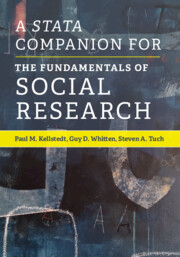Refine search
Actions for selected content:
36901 results in Cambridge Textbooks
Foreword
-
- Book:
- Australian Property Law
- Published online:
- 19 September 2022
- Print publication:
- 30 September 2022, pp v-vi
-
- Chapter
- Export citation

A Stata Companion for The Fundamentals of Social Research
-
- Published online:
- 29 September 2022
- Print publication:
- 08 September 2022
-
- Textbook
- Export citation
Chapter 18 - Reading Guide for Biblical Aramaic and Related Dialects
-
- Book:
- Biblical Aramaic and Related Dialects
- Published online:
- 08 September 2022
- Print publication:
- 29 September 2022, pp 264-354
-
- Chapter
- Export citation
Chapter 2 - Orthography
-
- Book:
- Biblical Aramaic and Related Dialects
- Published online:
- 08 September 2022
- Print publication:
- 29 September 2022, pp 19-26
-
- Chapter
- Export citation
4 - A Tour of Social Science Experiments
-
- Book:
- Social Science Experiments
- Published online:
- 08 September 2022
- Print publication:
- 29 September 2022, pp 42-67
-
- Chapter
- Export citation
Copyright page
-
- Book:
- Quantum Mechanics for Tomorrow's Engineers
- Published online:
- 06 June 2023
- Print publication:
- 29 September 2022, pp iv-iv
-
- Chapter
- Export citation
Chapter 4 - Nouns and Adjectives
-
- Book:
- Biblical Aramaic and Related Dialects
- Published online:
- 08 September 2022
- Print publication:
- 29 September 2022, pp 52-73
-
- Chapter
- Export citation
Dedication
-
- Book:
- Quantum Mechanics for Tomorrow's Engineers
- Published online:
- 06 June 2023
- Print publication:
- 29 September 2022, pp xi-xi
-
- Chapter
- Export citation
Chapter 17 - Discourse Markers (Half-Conjunctions)
-
- Book:
- Biblical Aramaic and Related Dialects
- Published online:
- 08 September 2022
- Print publication:
- 29 September 2022, pp 261-263
-
- Chapter
- Export citation
Chapter 9 - Prepositions
-
- Book:
- Biblical Aramaic and Related Dialects
- Published online:
- 08 September 2022
- Print publication:
- 29 September 2022, pp 116-138
-
- Chapter
- Export citation
Copyright page
-
- Book:
- Social Science Experiments
- Published online:
- 08 September 2022
- Print publication:
- 29 September 2022, pp iv-iv
-
- Chapter
- Export citation
Abbreviations and Notes
-
- Book:
- Biblical Aramaic and Related Dialects
- Published online:
- 08 September 2022
- Print publication:
- 29 September 2022, pp xiii-xiv
-
- Chapter
- Export citation
Subject Index (Numbers Refer to § Section)
-
- Book:
- Biblical Aramaic and Related Dialects
- Published online:
- 08 September 2022
- Print publication:
- 29 September 2022, pp 413-416
-
- Chapter
- Export citation
Chapter 1 - Introduction
-
- Book:
- Biblical Aramaic and Related Dialects
- Published online:
- 08 September 2022
- Print publication:
- 29 September 2022, pp 1-18
-
- Chapter
- Export citation
Solutions to Exercises
-
- Book:
- Social Science Experiments
- Published online:
- 08 September 2022
- Print publication:
- 29 September 2022, pp 110-139
-
- Chapter
- Export citation
5 - Research Ethics and Experiments Involving Human Subjects
-
- Book:
- Social Science Experiments
- Published online:
- 08 September 2022
- Print publication:
- 29 September 2022, pp 68-77
-
- Chapter
- Export citation
1 - Quantum-Enabled Technologies
-
- Book:
- Quantum Mechanics for Tomorrow's Engineers
- Published online:
- 06 June 2023
- Print publication:
- 29 September 2022, pp 1-12
-
- Chapter
- Export citation
Chapter 3 - Phonology
-
- Book:
- Biblical Aramaic and Related Dialects
- Published online:
- 08 September 2022
- Print publication:
- 29 September 2022, pp 27-51
-
- Chapter
- Export citation
2 - Electron Waves and Schrödinger’s Equation
-
- Book:
- Quantum Mechanics for Tomorrow's Engineers
- Published online:
- 06 June 2023
- Print publication:
- 29 September 2022, pp 13-33
-
- Chapter
- Export citation
Chapter 12 - Verb Types
-
- Book:
- Biblical Aramaic and Related Dialects
- Published online:
- 08 September 2022
- Print publication:
- 29 September 2022, pp 199-212
-
- Chapter
- Export citation
